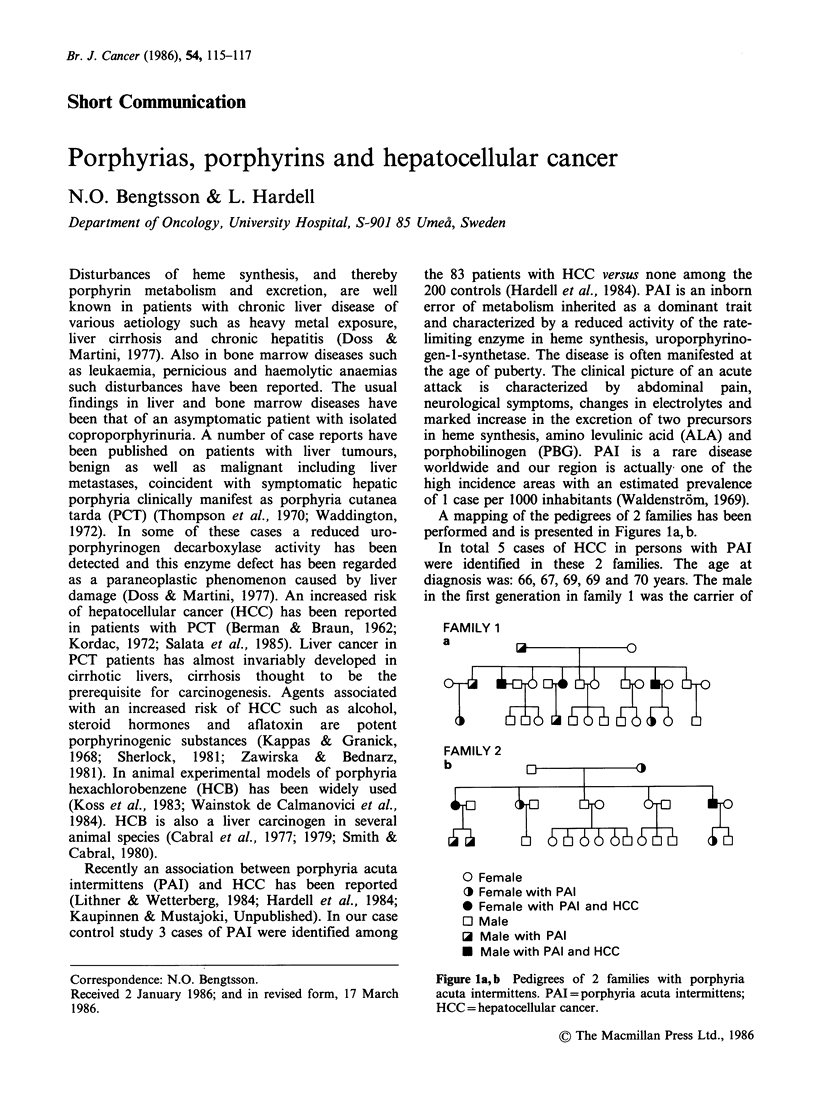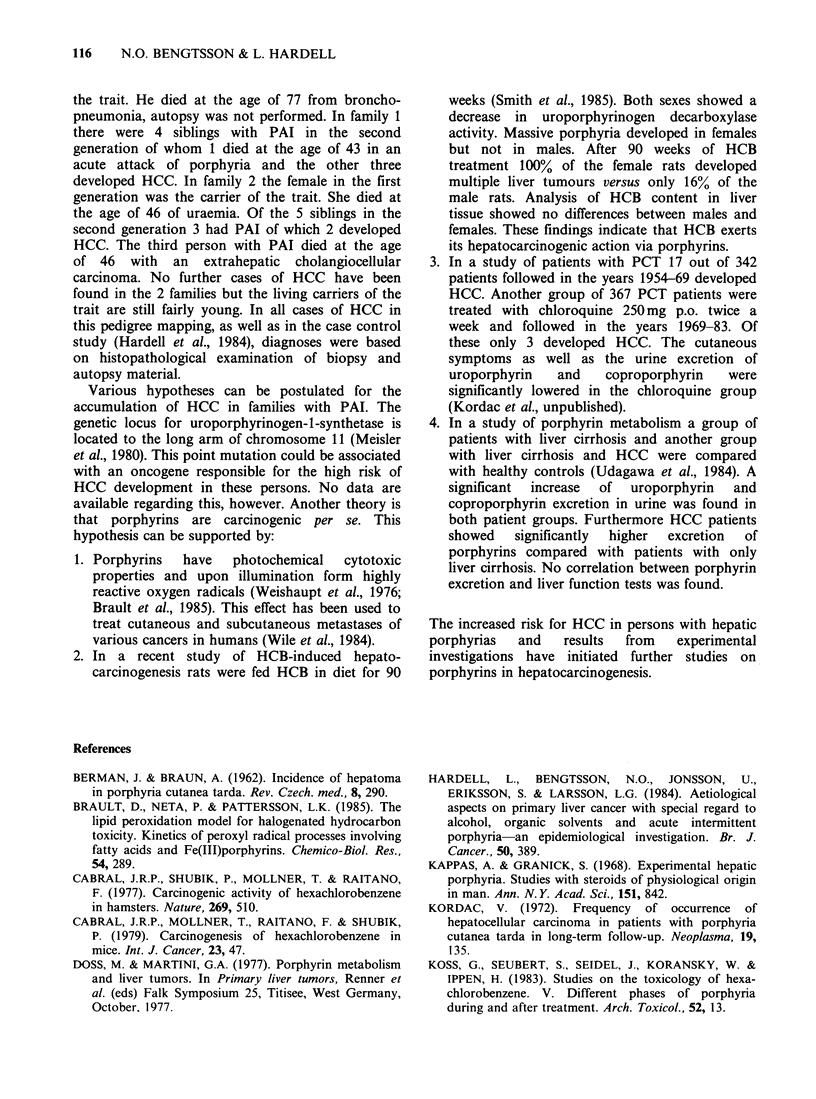Full text
PDF


Selected References
These references are in PubMed. This may not be the complete list of references from this article.
- BERMAN J., BRAUN A. Incidence of hepatoma in porphyria cutanea tarda. Rev Czech Med. 1962;8:290–295. [PubMed] [Google Scholar]
- Brault D., Neta P., Patterson L. K. The lipid peroxidation model for halogenated hydrocarbon toxicity. Kinetics of peroxyl radical processes involving fatty acids and Fe(III) porphyrins. Chem Biol Interact. 1985 Aug-Sep;54(3):289–297. doi: 10.1016/s0009-2797(85)80170-8. [DOI] [PubMed] [Google Scholar]
- Cabral J. R., Mollner T., Raitano F., Shubik P. Carcinogenesis of hexachlorobenzene in mice. Int J Cancer. 1979 Jan 15;23(1):47–51. doi: 10.1002/ijc.2910230110. [DOI] [PubMed] [Google Scholar]
- Cabral J. R., Shubik P., Mollner T., Raitano F. Carcinogenic activity of hexacholorobenzene in hamsters. Nature. 1977 Oct 6;269(5628):510–511. doi: 10.1038/269510a0. [DOI] [PubMed] [Google Scholar]
- Hardell L., Bengtsson N. O., Jonsson U., Eriksson S., Larsson L. G. Aetiological aspects on primary liver cancer with special regard to alcohol, organic solvents and acute intermittent porphyria--an epidemiological investigation. Br J Cancer. 1984 Sep;50(3):389–397. doi: 10.1038/bjc.1984.188. [DOI] [PMC free article] [PubMed] [Google Scholar]
- Kappas A., Granick S. Experimental hepatic porphyria: studies with steroids of physiological origin in man. Ann N Y Acad Sci. 1968 Jul 31;151(2):842–849. doi: 10.1111/j.1749-6632.1968.tb48268.x. [DOI] [PubMed] [Google Scholar]
- Kordac V. Frequency of occurrence of hepatocellular carcinoma in patients with porphyria cutanea tarda in long-term follow-up. Neoplasma. 1972;19(2):135–139. [PubMed] [Google Scholar]
- Koss G., Seubert S., Seubert A., Seidel J., Koransky W., Ippen H. Studies on the toxicology of hexachlorobenzene. V. Different phases of porphyria during and after treatment. Arch Toxicol. 1983 Jan;52(1):13–22. doi: 10.1007/BF00317978. [DOI] [PubMed] [Google Scholar]
- Meisler M., Wanner L., Eddy R. E., Shows T. B. The UPS locus encoding uroporphyrinogen I synthase is located on human chromosome 11. Biochem Biophys Res Commun. 1980 Jul 16;95(1):170–176. doi: 10.1016/0006-291x(80)90719-6. [DOI] [PubMed] [Google Scholar]
- Salata H., Cortés J. M., Enríquez de Salamanca R., Oliva H., Castro A., Kusak E., Carreño V., Hernandez Guío C. Porphyria cutanea tarda and hepatocellular carcinoma. Frequency of occurrence and related factors. J Hepatol. 1985;1(5):477–487. doi: 10.1016/s0168-8278(85)80746-7. [DOI] [PubMed] [Google Scholar]
- Smith A. G., Cabral J. R. Liver-cell tumours in rats fed hexachlorobenzene. Cancer Lett. 1980 Dec;11(2):169–172. doi: 10.1016/0304-3835(80)90108-1. [DOI] [PubMed] [Google Scholar]
- Smith A. G., Francis J. E., Dinsdale D., Manson M. M., Cabral J. R. Hepatocarcinogenicity of hexachlorobenzene in rats and the sex difference in hepatic iron status and development of porphyria. Carcinogenesis. 1985 Apr;6(4):631–636. doi: 10.1093/carcin/6.4.631. [DOI] [PubMed] [Google Scholar]
- Thompson R. P., Nicholson D. C., Farnan T., Whitmore D. N., Williams R. Cutaneous porphyria due to a malignant primary hepatoma. Gastroenterology. 1970 Nov;59(5):779–783. [PubMed] [Google Scholar]
- Udagawa M., Horie Y., Hirayama C. Aberrant porphyrin metabolism in hepatocellular carcinoma. Biochem Med. 1984 Apr;31(2):131–139. doi: 10.1016/0006-2944(84)90018-8. [DOI] [PubMed] [Google Scholar]
- Waddington R. T. A case of primary liver tumour associated with porphyria. Br J Surg. 1972 Aug;59(8):653–654. doi: 10.1002/bjs.1800590819. [DOI] [PubMed] [Google Scholar]
- Wainstok de Calmanovici R., Ríos de Molina M. C., Taira de Yamasato M. C., Tomio J. M., San Martin de Viale L. C. Mechanism of hexachlorobenzene-induced porphyria in rats. Effect of phenobarbitone pretreatment. Biochem J. 1984 Mar 15;218(3):753–763. doi: 10.1042/bj2180753. [DOI] [PMC free article] [PubMed] [Google Scholar]
- Weishaupt K. R., Gomer C. J., Dougherty T. J. Identification of singlet oxygen as the cytotoxic agent in photoinactivation of a murine tumor. Cancer Res. 1976 Jul;36(7 Pt 1):2326–2329. [PubMed] [Google Scholar]
- Wile A. G., Coffey J., Nahabedian M. Y., Baghdassarian R., Mason G. R., Berns M. W. Laser photoradiation therapy of cancer: an update of the experience at the University of California, Irvine. Lasers Surg Med. 1984;4(1):5–12. doi: 10.1002/lsm.1900040103. [DOI] [PubMed] [Google Scholar]
- Zawirska B., Bednarz W. The particular traits of carcinogenesis induced in Wistar rats by aflatoxin B1. III. Porphyrins and the activity of gamma-glutamyltranspeptidase in primary hepatomas and in their tissue of origin. Neoplasma. 1981;28(1):35–49. [PubMed] [Google Scholar]


